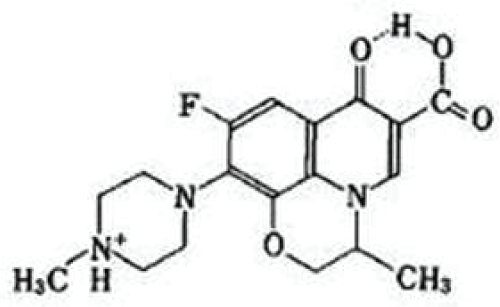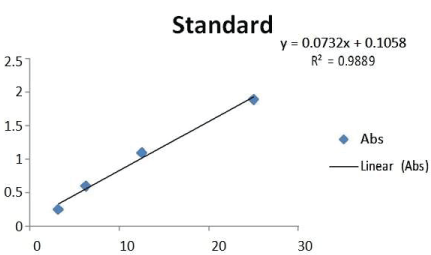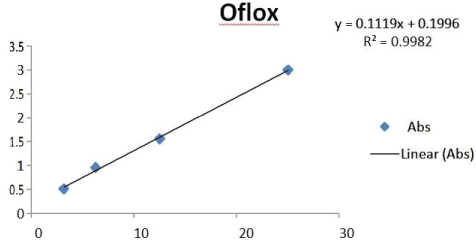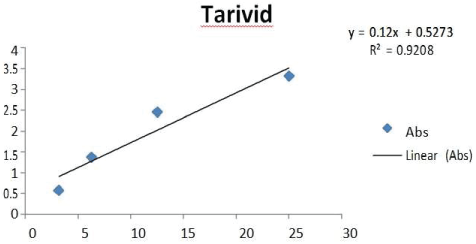Keywords
|
| Ofloxacin; Analysis; UV |
INTRODUCTION
|
| Heterocyclic quinolones stand for diverse biological and chemical reactivity [1].The Quinolonecarboxylic acids, carboxyquuinoloes, or 4- quinolones are a group of synthetic antibacterials structurally related to nalidixic acid. The term 4- quinolone has been used as a generic name for the common 4-oxo-1, 4- dihydroquinoline skeleton. Under this system nalidxic acid, a napthyridene derivative, is an 8- aza-4 quinolone, cinoxacin, a cinnoline derivative, is a 2-aza-4-quinolone, and pipemidic and piromidic acids, pyridopyrimidine derivatives, 6,8-diaza-4-quinolones [2,3] (Figure 1) . |
| Quinolones present a high degree of reticence against microorganisms. [4,5] Its inhibition for the gyrase enzyme is set by 2 genes gyrA and gyrB [6] .Gyrase inhibition is its primary inhibition effect. The study highlights Inter Pro Scan and molecular docking indicating that its the interaction ofloxacin and moxifloxacin with proteins which is hypothetical in nature with a conserved domain which causes the inhibition [7] .It suppresses gram negative and gram positive bacteria and caters both gram positive and gram negative bacterial infections [8,9] .It has a wide variety of applications as antibacterial, Anti- Infective Agents, Urinary; Nucleic Acid Synthesis Inhibitors [10]. Ofloxacin is substantially potent against Escherichia coli which is a challenge for other drugs like chloramphenicol and rifampiocin [11] .Ofloxacin (OFL) a fluorinated carboxyaquinolone, chemically is a racemate (+) -9fluro-2, 3-dihydro-3-methyl-10-(4-methyl-1piperazinyl)-7-oxo-7H-pyrido[1,2,3-de]-1,4benzoxazine-6- carboxylicacid. [12]Bacterial DNA gyrase, as compared to other enzymes is susceptible to 4-quinolone antimicrobials including ofloxacin which possess an additional killing mechanism [13]. Ofloxacin encounters anaerobic bacteria, chlamydiae, and some related organisms, such as mycoplasmas or mycobacteria [14] (Figures 2-4). |
Methodology
|
| UV-1800 Shimadzu double beam spectrophotometer was used for the measurement of the spectra. The solvent used was distilled water. |
| Preparation of Stock Solution: |
| 100ppm stock solution was prepared in the distill water for active and each of the two brands. 10mg of active was taken in a 100mL volumetric flask. Add sufficient water to dissolve the drug and make up the volume with same solvent to produce 100ppm solution. 100 ppm solution for each brand had been prepared by dissolving the ground tablets in a quantity calculated using theoretical weight and label claim in a 100mL volumetric flask. Add sufficient water to dissolve the drug and make up the volume with same solvent to produce 100ppm solution. |
| Selection of Wavelength |
| The 100ppm stock solution scanned between the UV ranges of 190-400nm. The wavelength corresponding to maximum absorbance of the drug was found at 294nm. |
| Procedure |
| Standard and tablets of each brand were used to prepare the 3 stock solutions of 100 ppm each. From this stock solution further dilutions were prepared having concentration of 25ppm, 12.5ppm, 6.25ppm and 3.125ppm. All these dilutions were scanned at UVVis spectrophotometer at 294nm using distilled water as blank. Calculate the regression by using regression equation. |
Result and Discussion
|
| An easy and cost effective analytical method of ofloxacin was developed by using active and 2 different brands of tablets (Oflox manufactured by Indus Pharma Batch # 1008 and Tarivid manufactured by Sanofi Aventis Batch # WD057) on spectrophotometer at 294 nm. The linearity relationship was obtained by preparing solutions of different concentration and regression was calculated. Solutions having concentrations of 25ppm, 12.5ppm, 6.25ppm and 3.125ppm were prepared and the absorbance was found to be directly proportional to the concentration. The result and linear trend line shows that absorbance increases with the increase in concentration. The regression and the correlation coefficient values also found to be with in the limit. |
Conclusion
|
| At different concentrations (25ppm, 12.5ppm, 6.25ppm and 3.125 ppm) a straight linear relationship was obtained (Table1). Absorbance was found to be directly proportional to concentration verifying Beers lambert law obtained in the concentration range of 3.125-25 ppm with correlation coefficents 0.988, 0.998, 0.920 for active ofloxacin, Oflox and Tarivid tablets respectively which meet the criteria mentioned in the ICH guide lines. The linear regression equation obtained by least square regression method were y = 0.073x + 0.105 for active, y = 0.111x + 0.199 for Oflox and y = 0.12x + 0.527 for Tarivid which also meet the criteria mentioned in the ICH guide lines, where y is the absorbance and x is the concentration of the pure drug solution. |
Tables at a glance
|
 |
| Table 1 |
|
| |
Figures at a glance
|
 |
 |
 |
 |
| Figure 1 |
Figure 2 |
Figure 3 |
Figure 4 |
|
| |
References
|
- Staško A1, Milata V, Barbieriková Z, Brezová V (2014) Oxidation of quinolones with peracids (an in situ EPR study). MagnResonChem 52: 22-26.
- Sweetman, Sean C (2002) Martindale, The pharmaceutical press, London: 113
- Yoshida, Atomi, Moroi R(1991)"Crystal structure of ofloxacin perchlorate." Analytical sciences 7.2: 351,352.
- Sheng ZG1, Peng S, Wang CY, Li HB , Hajela RK, et al. (2007) Apoptosis in microencapsulated juvenile rabbit chondrocytes induced by ofloxacin: role played by beta(1)-integrin receptor.J PharmacolExpTher 322: 155-165.
- Li Q1, Peng S, Sheng Z, Wang Y (2010) Ofloxacin induces oxidative damage to joint chondrocytes of juvenile rabbits: excessive production of reactive oxygen species, lipid peroxidation and DNA damage.Eur J Pharmacol 626: 146-153.
- Lata M1, Sharma D2, Deo N3, Tiwari PK4, Bisht D5, et al. (2015) Proteomic analysis of ofloxacin-mono resistant Mycobacterium tuberculosis isolates.J Proteomics .
- Lata M, Sharma D, Kumar B, Deo N, Tiwari PK, et al. (2015) Proteome analysis of ofloxacin and moxifloxacin induced mycobacterium tuberculosis isolates by proteomic approach.Protein PeptLett 22: 362-371.
- Drew RH1, Gallis HA (1988) Ofloxacin: its pharmacology, pharmacokinetics, and potential for clinical application.Pharmacotherapy 8: 35-46.
- Samanidou VF, DemetriouCE, Papadoyannis IN (2003) "Direct determination of four fluoroquinolones, enoxacin, norfloxacin, ofloxacin, and ciprofloxacin, in pharmaceuticals and blood serum by HPLC" Analytical and bioanalytical chemistry 375.5: 623-629
- National Library of Medicine's Medical Subject Headings online file (MeSH, 2012)
- Samanidou VF1, Demetriou CE, Papadoyannis IN (2003) Direct determination of four fluoroquinolones, enoxacin, norfloxacin, ofloxacin, and ciprofloxacin, in pharmaceuticals and blood serum by HPLC.Anal BioanalChem 375: 623-629.
- Mali, Digambar A, Bathe R, Tamboli A (2015) "Simultaneous determination of Cefiximetrihydrate and Ofloxacin in pharmaceutical dosage form by second order derivative UV spectrophotometry." International Journal of Advances in Pharmaceutical Analysis 5.2: 42-46
- Smith JT (1986) The mode of action of 4-quinolones and possible mechanisms of resistance.J AntimicrobChemother 18 Suppl D: 21-29.
- Macías-Cortés Edel C1, Llanes-González L2, Aguilar-Faisal L3, Asbun-Bojalil J3 (2015) Individualized homeopathic treatment and fluoxetine for moderate to severe depression in peri- and postmenopausal women (HOMDEP-MENOP study): a randomized, double-dummy, double-blind, placebo-controlled trial.PLoS One 10: e0118440.
-
|





